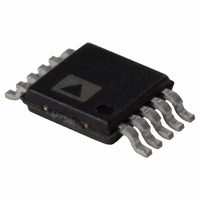AD5663RBRMZ-3 Analog Devices Inc, AD5663RBRMZ-3 Datasheet - Page 19

AD5663RBRMZ-3
Manufacturer Part Number
AD5663RBRMZ-3
Description
IC DAC NANO 16BIT 1.25V 10-MSOP
Manufacturer
Analog Devices Inc
Series
nanoDAC™r
Specifications of AD5663RBRMZ-3
Data Interface
Serial
Settling Time
4µs
Number Of Bits
16
Number Of Converters
2
Voltage Supply Source
Single Supply
Power Dissipation (max)
5mW
Operating Temperature
-40°C ~ 105°C
Mounting Type
Surface Mount
Package / Case
10-MSOP, Micro10™, 10-uMAX, 10-uSOP
Resolution (bits)
16bit
Sampling Rate
220kSPS
Input Channel Type
Serial
Supply Voltage Range - Analog
2.7V To 3.6V, 4.5V To 5.5V
Supply Current
800µA
Lead Free Status / RoHS Status
Lead free / RoHS Compliant
For Use With
EVAL-AD5663REBZ - BOARD EVAL FOR AD5663
Lead Free Status / RoHS Status
Lead free / RoHS Compliant, Lead free / RoHS Compliant
Available stocks
Company
Part Number
Manufacturer
Quantity
Price
Part Number:
AD5663RBRMZ-3
Manufacturer:
ADI/亚德诺
Quantity:
20 000
Digital Crosstalk
Digital crosstalk is the glitch impulse transferred to the output
of one DAC at midscale in response to a full-scale code change
(all 0s to all 1s and vice versa) in the input register of another
DAC. It is measured in standalone mode and is expressed
in nanovolts-second (nV-s).
Analog Crosstalk
Analog crosstalk is the glitch impulse transferred to the output
of one DAC due to a change in the output of another DAC. It is
measured by loading one of the input registers with a full-scale
code change (all 0s to all 1s and vice versa) while keeping LDAC
high. Then pulse LDAC low and monitor the output of the DAC
whose digital code was not changed. The area of the glitch is
expressed in nanovolts-second (nV-s).
DAC-to-DAC Crosstalk
DAC-to-DAC crosstalk is the glitch impulse transferred to the
output of one DAC due to a digital code change and subsequent
output change of another DAC. This includes both digital and
analog crosstalk. It is measured by loading one of the DACs
with a full-scale code change (all 0s to all 1s and vice versa) with
LDAC low and monitoring the output of another DAC. The
energy of the glitch is expressed in nanovolts-second (nV-s).
Rev. C | Page 19 of 28
Multiplying Bandwidth
The amplifiers within the DAC have a finite bandwidth. The
multiplying bandwidth is a measure of this. A sine wave on the
reference (with full-scale code loaded to the DAC) appears on
the output. The multiplying bandwidth is the frequency at
which the output amplitude falls to 3 dB below the input.
Total Harmonic Distortion (THD)
Total harmonic distortion is the difference between an ideal
sine wave and its attenuated version using the DAC. The sine
wave is used as the reference for the DAC, and the THD is a
measurement of the harmonics present on the DAC output.
It is measured in decibels (dB).
AD5623R/AD5643R/AD5663R













